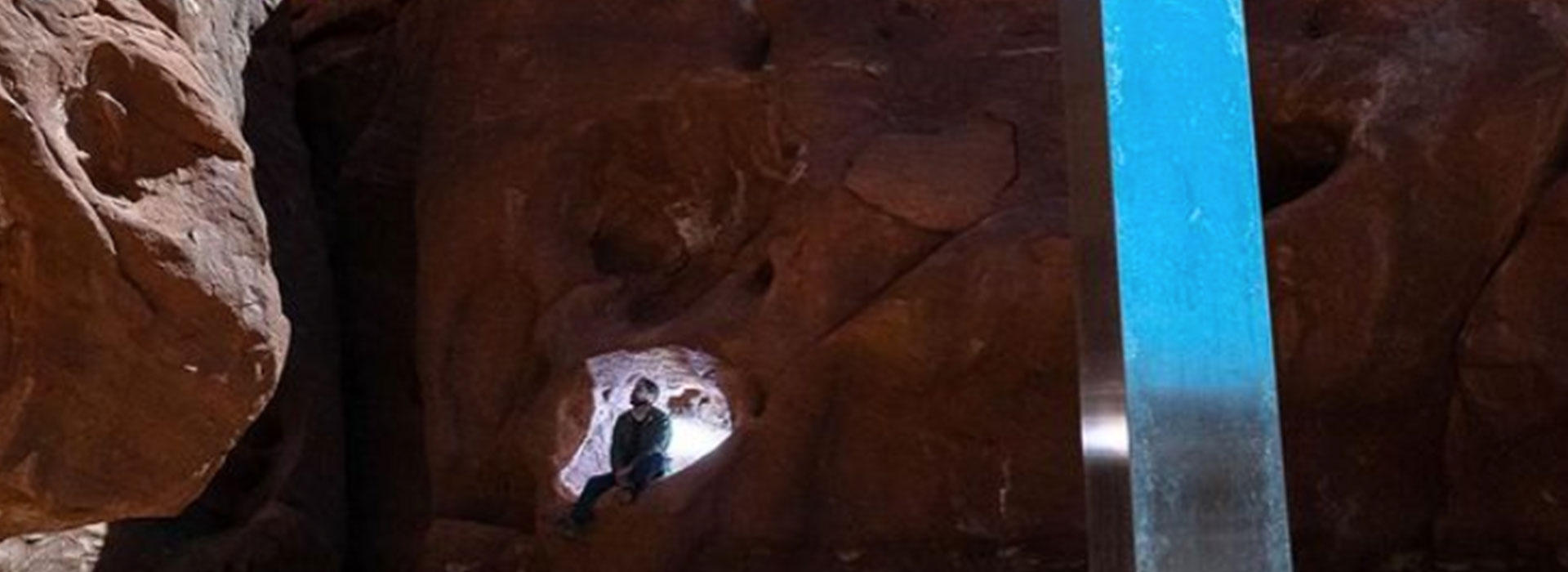Sketchy Art
By Chris Van Leuven

You’d have to be from a different planet to have missed November and December’s news about the monolith in Utah’s San Juan County outside of Canyonlands in Lockhart Basin, 17 miles southwest of Moab. “A Weird Monolith is Found in the Utah Desert,” The New York Times declared on Nov. 24, inspiring a flurry of public interest.
The mysterious monolith’s appearance pro-vided some respite from political news. Some questioned if aliens had placed it there. Others compared its shape to a similar one discovered in the desert landscape—where apes become mesmerized by it—in Stanley Kubrick’s 1968 film 2001: A Space Odyssey. The New York Times confirms that the structure is the work of the late artist John McCracken, a science fiction fan. A YouTube clip from the movie was viewed close to 900,000 times, and one viewer commented, “This goes to show that, even in 2020, we are still apes who don’t know what to do when a metal object pops up from the Earth!”
Sleuths digging through the internet for information resulted in gaggles of people descending on the fragile desert landscape. Then, in an act that got him labeled a “Desert Karen,” Andy Lewis (aka Sketchy Andy), the owner of BASE Jump Moab and Reel Rock film star who is often called the best slackline in the world, hauled away the monolith with the help of friends under the cover of darkness.
Lewis told Grit Dailyhe had to protect the area to keep it from being trampled by “people (who) arrived by car, by bus, by van, helicop-ter, planes, trains, motorcycles, and e-bikes.” (In a twist, shortly after the Utah monolith disappeared, others appeared throughout the world, including in the U.K., Vancouver, Southern California, Hungary, and Romania. One even popped up at a Holidaze in Fayetteville, Arkansas, where the cocktail bar uses the metal structure to entice customers.)
No stranger to publicity, Lewis posted a vid-eo of the removal of the monolith on YouTube; by Dec. 21, it had been viewed 76,000 times. The text accompanying the video reads: “On the night of Nov. 27, 2020, at about 8:30 p.m., our team removed the Utah Monolith. We will not be including any other information, an-swers, or insight at this time.”
“I’m totally the person (who removed it),” Lewis says. “It’s a bigger story … this is bigger than anyone can think. It’s about a dis-traction from what is actually happening in the desert. We did this for no other reason than positivity. We are artists ourselves.” On social media, Lewis claimed his motives to remove the art were to protect the fragile area where it was found and create a dialogue about “land management techniques and the impor-tance of the natural world, its native people, plants, and inhabitants.” He continued, “It was a tragedy to remove the Utah Monolith … and we do apologize.”
The Bureau of Land Management con-firmed the removal of the illegally installed steel structure and also addressed the prob-lems it caused, stating: “Visitors who flocked to the site parked on vegetation and left behind human waste as evidence of their visit.”
Posting from Moab on Dec. 21, Lewis showed a video of the monolith upright in what appeared to be someone’s backyard. Other than faint mark-ings on it, likely left over from transportation, it was shining in the sun, just as it had stood un-disturbed in the desert. After checking with his lawyers, and in a post to his 370,000 Instagram followers, Lewis wrote: “We took it because it was leading to irreparable damage to the area; permanently—but the idea behind the art—as well as the art, was beautiful. We also had heard about plans to completely destroy it that night.”
His post continued, stating that the monolith is now in the Bureau of Land Management’s possession, and there will be a full investigation into how it got placed where it was and why.
